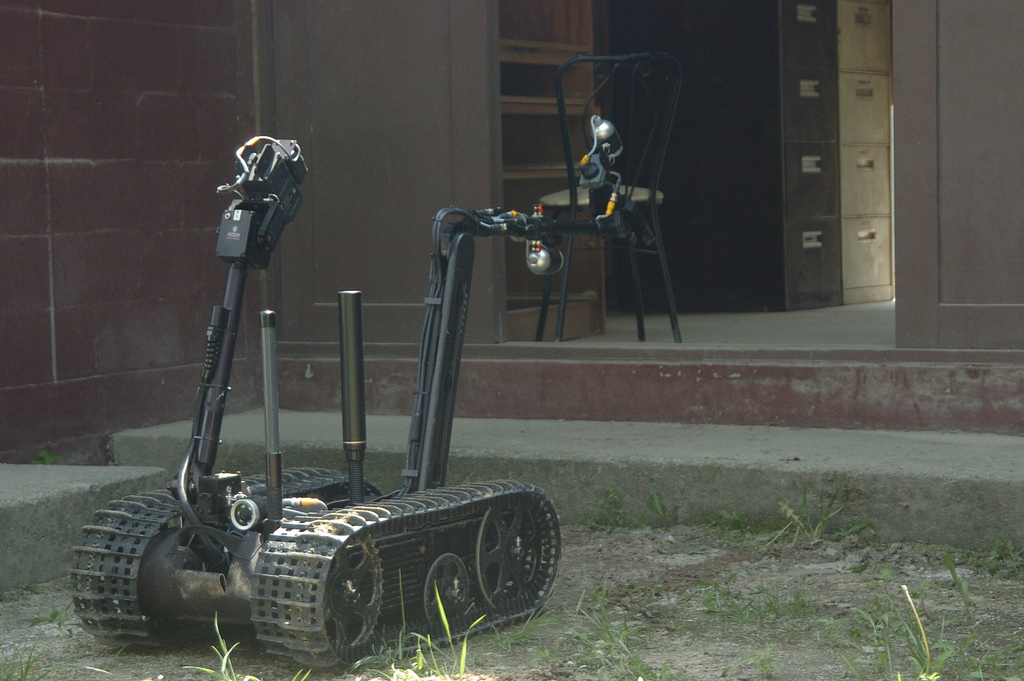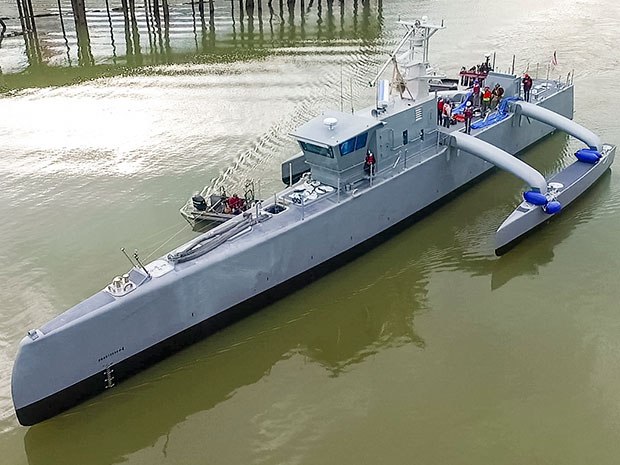Last year, a leading group of academics and AI scientists called for a complete ban on “offensive autonomous weapons beyond meaningful human control.” The letter was signed by more than 20,000 people, including luminaries like Stephen Hawking, Elon Musk, Stuart Russell, Max Tegmark, and Toby Walsh. The initiative was also endorsed by many human rights groups and is currently on the December 2016 agenda of the United Nations disarmament meeting in Geneva.
In light of all the science fiction movies that have predicted a robotic apocalypse since Karel Čapek’s famous play, “R.U.R.,” the petition makes sense. However, the alternative, in lieu of a messianic age of world peace, is more human death. Our enemies are not going away and threaten peaceful coexistence everywhere. Just this week, ISIS burned 19 Yazidi girls alive after they refused to have sex with their captors. Saving these victims from the clutches of the terrorists would have required a lot of manpower, unless one could use robots in advance of the human mission.
A company focused on such hostage situations is Israeli-based General Robotics. Their newest robot, Dogo, is a small remote-controlled device designed for law enforcement and military use and is capable of firing a pistol. The 26.5-pound backpack robot will be formally unveiled next at the Eurosatory defense exhibition in Paris. The gun-toting bot is named after the vicious Argentine Mastiff. Unlike the large canine, the robotic Dogo is only 5.5 inches tall in stealth mode and 11 inches when fully deployed. The robot rolls along at 2.5 miles per hour on treads that can travel up stairs and over obstacles. Its battery lasts between 2-5 hours and the robot contains an array of sensors and video cameras that provide the handler with real-time, 360-degree information from a safe distance.
“Our slogan is risk the Dogo, not personnel,” said the company’s CEO, retired Col. Udi Gal.
Unlike other small robots that can only serve in a surveillance capacity, the Dogo has a compartment specially designed to hold and fire a subcompact Glock 9mm pistol. The offensive robot can hold up to 14 rounds of ammunition and operates through a point and shoot mobile interface. The operator uses a tablet to identify a target on screen, while the robot takes out the terrorists with pinpoint precision. As an alternative to bullets, police can load nonlethal ammunition—such as pepper spray and electric tasers—to neutralize a subject.
The Dogo is not the first robotic weapon in the marketplace. The fact is that robot weapons, like iRobot’s packbot, have existed for decades. While fully autonomous weapons are deployed in the field, most are exclusively sold for defensive purposes. One example is the Phalanx, a computer-controlled, radar-guided gun system installed on many U.S. Navy ships that can automatically detect, track, evaluate, and fire at incoming missiles and aircraft that it finds to be a threat. When it’s in fully autonomous mode, no human intervention is required.
More recently, military suppliers have developed what may be considered the first offensive autonomous weapons. Israel Aerospace Industries’ Harpy and Harop drones are designed to home in on the radio emissions of enemy air-defense systems and destroy them by crashing into them. The company says the drones “have been sold extensively worldwide.”
In South Korea, DoDAAM Systems, a defense contractor, has developed a sentry robot called the Super aEgis II. Equipped with a machine gun, it uses computer vision to autonomously detect and fire at human targets out to a range of 3 kilometers. South Korea’s military has reportedly conducted tests with these armed robots in the demilitarized zone along its border with North Korea. DoDAAM says it has sold more than 30 units to other governments, including several in the Middle East.
Today, highly autonomous systems are vastly outnumbered by robotic weapons such as drones, which are under the control of human operators most of the time, especially to fire at targets. However, some analysts believe that as warfare continues to evolve, weapons will have higher and higher degrees of autonomy. The U.S. military has detailed some of its plans for this new kind of war in a road map for unmanned systems, but its intentions to weaponize such systems are vague. In a Washington Post forum this past March, U.S. deputy secretary of defense Robert Work, whose job involves ensuring that the Pentagon keeps up with technology, stressed the need to invest in AI and robotics. The increasing presence of autonomous systems on the battlefield “is inexorable,” he declared.
When he was asked about autonomous weapons, Work insisted that the U.S. military “will not delegate lethal authority to a machine to make a decision.” But when pressed on the issue, he added that if confronted by a “competitor that is more willing to delegate authority to machines than we are…we’ll have to make decisions on how we can best compete. It’s not something that we’ve fully figured out, but we spend a lot of time thinking about it.”
Russia and China follow a similar strategy to develop unmanned combat systems for land, sea, and air that are weaponized, but currently rely on human operators. Russia’s Platform-M is a small, remote-controlled robot equipped with a Kalashnikov rifle and grenade launchers—a type of system similar to the United States’ Talon SWORDS, a ground robot that can carry an M16 and other weapons (it was tested by the U.S. Army in Iraq). Russia has also built a larger unmanned vehicle, the Uran-9, armed with a 30-millimeter cannon and antitank guided missiles. Last year, the Russians demonstrated a humanoid military robot to a seemingly unimpressed Vladimir Putin (as in the video the robot is shown riding an ATV at a speed only slightly faster than a child on a tricycle).
China’s growing robotic arsenal includes numerous attack and reconnaissance drones. The CH-4 is a long-endurance unmanned aircraft that resembles the Predator used by the U.S. military. The Divine Eagle is a high-altitude drone designed to hunt stealth bombers. China has also publicly displayed a few machine-gun-equipped robots, similar to Platform-M and Talon SWORDS, at military trade shows.
The three countries’ approaches to robotic weapons, which increase automation while emphasizing a continuing role for humans, pose a major challenge to the banning of fully autonomous weapons: A ban on fully autonomous weapons would not necessarily apply to weapons that are nearly autonomous. So, militaries could conceivably develop robotic weapons that have a human in the loop, with the option to enable full autonomy at a moment’s notice in software.
In April, Deputy Secretary Work christened the new robotic submarine, “Sea Hunter” (above). The unarmed, experimental 132-foot-long, ship is designed to search for enemy submarines. According to DARPA, no human will ever step foot aboard the Sea Hunter, so its designers didn’t have to worry about “accessibility” or “crew support systems.” This led to a more scalable economic structure—as the ship costs around $20 million to build and requires $15,000 to $20,000 in daily operating costs—significantly less than a typical human-operated attack sub. Experts say autonomous vessels like Sea Hunter are important because they will help the U.S. compete with similar advancements made by Russia and China.
In his remarks, Work stated, “We are in a period of incredible technological flux. Advances in autonomy and artificial intelligence and autonomous control systems and advanced computing and big data and learning machines and intuitive rapid visualization tools, meta-materials, miniaturization. They are leading us to a period of a time of great human-machine collaboration.”
For now, humans seems to be in the loop as a safe-guard measure, but warfare expert, Peter W. Singer, predicts that in future combat scenarios—like a dogfight between drones or an encounter between a robotic boat and an enemy submarine—weapons that offer a split-second advantage will make all the difference. In Singer’s words, “It might be a high-intensity straight-on conflict when there’s no time for humans to be in the loop, because it’s going to play out in a matter of seconds.”
Let’s all pray for world peace.
Image Credit: CC by UNC-CFC-USFK





